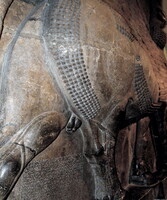Colossal winged bull from the Palace of Sargon II
unknown (Assyrian sculptor)

Download7A3-A-BM-KPS-A6_cp.jpg (662.2Kb)
Alternative Titles
Human-headed winged bull
Lamassu (guardian figure)
Date
-710--705Description
Detail, back legs of bull; This is one of a pair of colossal human-headed winged bulls, magical figures which once guarded an entrance to the citadel of the Assyrian king Sargon II (721-705 BC). Late in his reign Sargon built himself a new capital city, which he called Dur-Sharrukin ('the fortress of Sargon'), known today as Khorsabad. Among the buildings was a magnificently sculptured palace, which was discovered by the French archaeologist Paul-Emile Botta between 1842 and 1844. When the French abandoned the site they left behind the pair of bulls because they were too heavy to move. In 1849 Henry Rawlinson, the British Resident in Baghdad, bought them from the French consul, and resolved the problem of their weight - about sixteen tons of alabaster each - by having them sawn into several bits. Source: British Museum [website]; http://www.britishmuseum.org (accessed 6/14/2009)
Type of Work
sculpture (visual work)Subject
deities, literary or legendary, rulers and leaders, archaeology, mythical beasts, fantastic animals, Neo-Assyrian, Late Assyrian, lamassu, Assyrian
Rights
Rights Statement
Licensed for educational and research use by the MIT community only